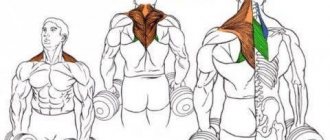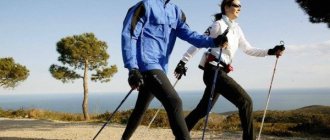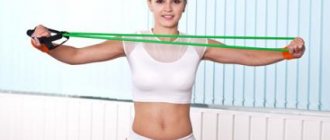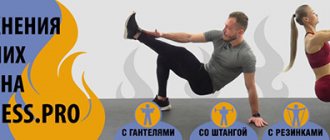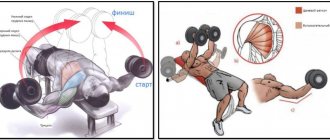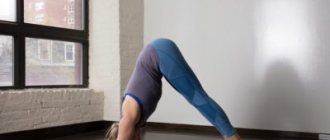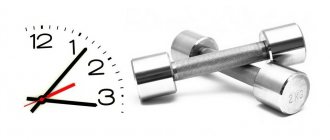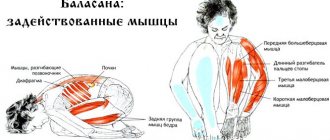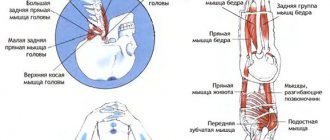Content
- 1 Competition poses in bodybuilding
- 2 Relaxed posture 2.1 Important points
- 3.1 Double biceps front classic bodybuilding pose
- 4.1 Double biceps back
- 5.1 Side chest
Poses with your back to the judges [edit | edit code]
There are four mandatory poses here:
- double biceps at the back;
- latissimus posterior;
- caviar;
- thigh biceps.
Back double biceps [edit | edit code]
This is almost the same as a "front double biceps" but some muscles need to be emphasized. This pose shows not so much the development of the biceps, but rather the thickness and detail of the back. Therefore, the elbows need to be pulled back a little to contract the muscles of the upper back and rear deltoids. The loin should be slightly arched to show the separation known as herringbone. And don't forget to tighten your hamstrings and calves.
Lat rear[edit | edit code]
Latissimus rear
– this pose demonstrates the width of the back. It’s not the thickness that’s important here, but the width, so try to spread your lats out to the sides as much as possible.
Hamstrings/Calves [ edit | edit code]
This pose is not always called, but may be asked to show the hamstrings and calves from behind separately. The hamstrings are shown by raising the heel towards the gluteals, and the calves are shown by standing on the toes. There are no specific standards, and not every panel of judges will ask you to do this pose, but it's worth practicing just in case.
Relaxed pose
The mandatory posing begins with a relaxed pose facing the judges, followed by four 90-degree turns. In a relaxed position, it is important to always keep your chest high, your shoulders and lats fully extended, and your arms and legs tense. Ideally, all this should be done with a smile or at least without a grimace of pain on your face. Each quarter turn is always done to the right—never to the left. The first turn is done to show the judges the left side of the body, the next another quarter turn to show the back, another quarter turn to show the right side and finally the last one to face the judges again.
Turn in a military manner, moving your right leg back and then turning your left. While rehearsing, gradually learn to make smooth and relaxed movements. The position facing the judges sideways is one of the most difficult because it makes almost everyone look “skinny”, not as massive as they do from the front or back. Therefore, you need to learn to look as massive as possible in it.
In the first quarter turn, with your left side facing the judges, place your left leg slightly in front of your right, this will allow your lower body to look wider and more solid. Turn your left knee slightly inward to better show your left hamstring to the judges. In addition, the judges will also see part of the right leg, which will add depth to the lower body; the left leg should not be placed too far in front of the right. The left heel should be close to the arch of the right foot - no further. Don't rise up on your toes. The judges pay strict attention to this. If they see that you are stepping too far forward, they may reprimand you.
Important points
The abdominal muscles need to be kept tight - this is one of the most important aspects of the pose sideways to the judges. If the stomach is relaxed, this will be noted immediately. But if you hold your stomach, then no problems will arise. Posing is hard work, so you will need stamina. If you start breathing heavily, it will immediately become noticeable in your stomach. Therefore, practice to train your body to accept any pose with easy breathing. In the side pose, the chest should be raised high and the shoulders should be slightly turned towards the judges. This will improve the impression of the figure. Remember that at the same time as your shoulders, you must slightly bend your left knee and turn it inward, away from the judges. This will create the necessary tension and rotation in the waist, and will also help keep the stomach tucked in. The next thing is to tense your left arm, and if you have large pectoral muscles, contract your right arm while turning your shoulders towards the judges. Repeat the same in the pose with your right side facing the judges. When you turn your back, the elements of the pose will be the same as in the full face, that is, chest raised high, arms extended and arms tense. Also be sure to tighten your hamstrings and calves instead of your quadriceps, which won't be visible. Also, tighten your triceps more than your biceps.
A little about competitive poses in bodybuilding
Experienced athletes devote at least an hour a day to mastering bodybuilding poses, because a careless attitude towards them sometimes costs victory. These are the poses that every athlete must be able to take so that the judges can compare him with other participants. And this is real art.
Any bodybuilding exhibition begins with a relaxed pose, facing the judges. This pose consists of turning 90 degrees four times. All turns are performed clearly, like a soldier on drill, because by turning awkwardly, you will make this process funny, which will not add points to you.
Turn only to the right, showing the left side of the body, the back, the right side and finally return to face the judges. When performing this pose, it is very important to keep your chest high, your shoulders and massive back completely relaxed, but your arms and legs tense.
Do not forget that it is better to accompany any posing with a smile, because its absence will show a not very pleasant grimace of pain.
Of all the turns, the sideways turn is the most difficult. The goal of this turn is to show yourself as wide and massive as possible, but due to the structural features of our body, everyone here looks “narrow”.
When turning to the left side, we slightly put our left leg forward, while bending the knee slightly and turning it inward, which allows us to demonstrate the hamstring biceps as much as possible. When making a turn, your right leg will be clearly visible, which will only be beneficial. Just don't overdo it.
When placing your left foot, pay attention to the heel - it should stand next to the arch of the right foot and not rise to the toe. Otherwise you will receive a reprimand from the judges.
Let's look above. Having your chest raised high and your shoulders slightly turned towards the judges will improve the impression of your figure. One of the most important aspects of the side pose is the abdominal muscles - they should always be tense.
And turning the knee of the left leg inward will help us create the necessary tension and rotation at the waist, as well as keep the stomach pulled in. Next, we strain our left arm, and if you are the owner of large pectoral muscles, you can shorten your right arm while turning your shoulders towards the judges.
When showing the right side, we do everything the same, but exactly the opposite, that is, we bend our right leg and strain our right arm.
The face and back turns are very similar: shoulders wide and chest high. Particular attention is paid to the triceps, which is clearly visible when the arms are tense. The legs show off the hamstrings and calves.
Poses facing the judges
When posing facing the judges, there are five required poses.
Double biceps front
– a classic element of posing in bodybuilding. It’s clear here that the key muscles here are the biceps.
Particular attention is paid to the legs, which need to be tensed as much as possible to show the definition of the hips. The abdominal muscles should be pulled in, but not tense, the chest should be raised high, and the shoulder sections of the arms should be parallel to the floor.
There are many options for performing this pose and there is plenty to choose from, but it is Arnold’s style that is recognized as classic. While doing this pose, remember to be relaxed and even smile.
Lat front pose
demonstrates to the judges the width of the shoulders and the size of the back muscles. When getting into this position, you don’t need to strain your chest too much. Here it is important to hold your chest as high as possible and straighten your shoulders as much as possible. If you have a thick enough chest, you can bring your elbows forward and contract your pectoral and abdominal muscles, as Franco Colombo did.
Showing off your abs
, you will definitely have to put your hands behind your head and contract your abdominal muscles. The most important thing in this pose is to exhale as much air as possible and try to strongly contract your abs. When performing this pose, do not forget about the legs, which are very clearly visible, so you can also show off the quadriceps.
HP or, as it is also called, the “most muscular” pose.
This showcases the overall thickness, quality and development of the muscles of the chest, arms and shoulders. This is one of the most difficult poses because you need to contract as many muscles as possible.
The main thing is not to neglect the rule - the weaker the chest and shoulders look, the further away from the body you need to place your hands and vice versa. This pose cannot be avoided, since the overall form of the athlete is judged by it, and the audience really likes it.
The fifth, but important pose is showing the quadriceps.
The pose has optional status, but sometimes judges ask to show it.
Here, facing the judges, hands are placed on the hips or rested on the sides, while the upper body must be relaxed without losing control of the abdominal muscles. Then one leg is put forward, and the muscles contract harshly.
Some athletes with large muscle mass effectively shake their quadriceps before contracting.
Poses with your back to the judges
With their backs to the judges, athletes perform the following three elements.
1.
Back Double Biceps
This move is very similar to the front double biceps pose. The only difference is the demonstration not of the biceps itself, but of the development of your back muscles. For better display, we move our elbows back a little, which helps in contracting the upper back and deltoids. Then we slightly arch our lower back, so we can better show the muscles, better known to us as “Christmas trees.” You also need to tighten your hamstrings.
2. Latissimus posterior
In this pose, judges evaluate your maximum back width. So feel free to open your lats as wide as possible.
3. Hamstrings (calves)
This is one of the optional elements of posing, however, the judges may ask you to do it. To show off your hamstrings, you need to raise your heel towards your buttocks, and to show off your calves, just stand on your toes. Everything is simple here, since there are no posing rules.
Poses sideways to the judges
In this position, judges evaluate only the chest and triceps.
1.
Side Chest
To perform this pose correctly, the athlete lifts one leg onto his toes and turns his knee away from the judges. This will show off the hamstrings better.
Raising your chest high, and also bending one shoulder towards the judges, slightly tense its muscles. Place your palms together under your chest and make sure that the hand facing the judges is down and tense.
Remember that there should be no gap between your arms and torso.
2.
Side Triceps
In this pose, the legs remain in the same position as in the previous element. Then we clasp our hands behind us and straighten and strain the triceps of the arm turned towards the judges as much as possible. Don't forget that your stomach should be pulled in and your head should be turned towards the judges.
Source: https://powerinside.com.ua/aktualnye-temy/nemnogo-o-sorevnovatelnih-pozah-v-bodibildinge/
Double biceps front classic bodybuilding pose
It is clear that the key muscles here are the biceps. There are many options here, but Arnold's style is recognized as classic. The legs should be tense to show the definition of the hips. The abdominal muscles are drawn in, but not tense, the chest is raised high, and the shoulder sections of the arms are parallel to the floor. The biceps should be reduced as much as possible, but you should also look relaxed and smile. Some athletes raise their elbows higher. This version was brought into fashion by Steve Reeves, and Lee Haney did the same - there should be no comments from the judges in this case.
Judging women's competitions (bodybuilding)
The judging procedure must be the same as for men, including weigh-in.
The Chief Judge has the right to inspect any competitor's costume at the pre-competition weigh-in and during the competition to ensure that the costume complies with IFBB rules: bikini bottoms must cover 1/2 of the buttocks, and the use of shiny, brocade or printed fabric in the costume is strictly prohibited.
1. Assessment of mandatory poses for women:
- "Double biceps front"
- "Biceps side"
- "Double biceps at the back"
- "Triceps side"
- "Abs thigh"
Side chest
Side chest
– this pose begins by lifting one leg and placing it on the toe. You then turn your knee away from the judges to better show them your hamstrings. At the same time, place your palms together under your chest (the arm being demonstrated is from below), lift your chest as high as possible, slightly tense the pectoral muscle that you are not demonstrating, and lean one shoulder towards the judges. There should be no gap between the arms and torso. And finally, tense your hand towards the judges, turn your gaze towards them and smile.
What do the categories “Fit Model” and “Fit Bikini” have in common?
In these two categories, not only the body is evaluated, but also the entire image, face, costume, posing. The difference between them is that in the fitness bikini category, athletes are more muscular and have well-developed muscles.
Behind the scenes of the Altai Territory Open Bodybuilding Championship 2019
Irina Pergaeva
Behind the scenes of the Altai Territory Open Bodybuilding Championship 2019
Irina Pergaeva
Behind the scenes of the Altai Territory Open Bodybuilding Championship 2019
Irina Pergaeva
Behind the scenes of the Altai Territory Open Bodybuilding Championship 2019
Irina Pergaeva
Behind the scenes of the Altai Territory Open Bodybuilding Championship 2019
Irina Pergaeva
Behind the scenes of the Altai Territory Open Bodybuilding Championship 2019
Irina Pergaeva
True, there are a couple of exceptions. Girls in fitness bikinis should not have six-pack abs or “divide” shoulders. Not everyone can compete in this category.
“These are girls who are genetically predisposed to slimness. They have a naturally thin waist, narrow ankles, and a beautiful face and chest,” explained Alexander Barbashin.
Becoming a fit model is a little easier. This category is suitable for active gym goers who are on a diet and decide to take part in competitions. Preparation for such launches may take a couple of months.
Behind the scenes of the Altai Territory Open Bodybuilding Championship 2019
Irina Pergaeva
Training and nutrition
The nutrition rules are the same for everyone, bodybuilders just have to eat more calories to maintain their huge muscle volumes. In addition, during the period of weight gain, bodybuilders can afford to overeat on carbohydrates and even fats, while beachgoers need to strictly monitor the amount of carbohydrates and fats they consume.
There are also virtually no differences in the training process between bodybuilders and representatives of Men`s Physique; beachgoers work in the gym no less than heavyweights. Compare the back training of the vice-champion of two amateur Olympias, Ivan Vodyanov, and the star of Men`s Physique, Denis Gusev.
Why is flexibility needed?
Yoga practice gradually relaxes the ligaments and joints and the muscle tissue around the joints, which allows blood to flow more easily to them. Relieves joint pain.
Since the joints are stretched, they become more mobile, which allows more oxygen and nutrition to be delivered to the cartilage tissue.
Both of these factors are very important in preventing arthritis and with all these benefits, yoga helps you recover faster from your workouts.
Most strength exercises focus on repetitions. associated with constant muscle contraction, and this shortens the muscles. Such exercises include squats and bench presses. And this leads to decreased mobility.
Reduced mobility can eventually lead to injury, for example, if you switch to an unfamiliar form of exercise.
This happens because your muscles, although strong but short, refuse to stretch. This leads to breaks.
4. You have the “wrong” backbone
Even before you start training, you can estimate the prospects for the structure of the skeleton. A short torso, narrow shoulders, a wide pelvis, long humerus and femurs are a death sentence. You don’t have to choke on chicken breast, no matter how much mass you gain, your backbone is not a champion’s.
This does not mean that you have no chance at all. With the right training and diet, you may be able to place in the top ten at small regional competitions, but you are unlikely to win anything at high level competitions.
Pharmacology
If in big bodybuilding pharmacology is an indispensable component of success, and without its use in competitions there is nothing to do, then the muscles necessary for Men`s Physique can be developed without the use of pharmacology. Another factor preventing the active use of pharmacology in Men's Physique is a large number of side effects, many of which, for example, hair loss or skin problems, can cause defeat in competitions.
Denis Gusev, winner of Arnold Classic Europe and Neva Pro Show in the Men's Physique category:
— At the beginning of my career, I competed in classical bodybuilding - this is a discipline in which there are restrictions on the height-weight ratio. But if classical bodybuilding is quite popular in Russia, in the West it has long died due to the lack of a professional league. Therefore, the emergence of the Men`s Physique category came in handy. Its advantages over big bodybuilding are smaller volumes, greater aesthetics and, of course, the fact that you can prepare for competitions much faster. But this does not mean that Mens Physicist is easy; you have to work hard in training no less than heavyweight bodybuilders. Any professional sport is working to the limit, and it doesn’t matter what discipline you compete in.
As you can see, there aren't that many differences. In any case, everyone in the gym has to work the same way. Well, it’s up to you to decide who to look up to, huge bodybuilders or slender beachgoers.
Previous Prescription protein: deputies want to limit the sale of sports nutrition
Next Do the splits: how, for how long and why you need it
1. You have no relief
The first point is my favorite. Competitive bodybuilders know that to get defined, veiny muscles with clearly visible tufts, you have to go through drying hell. There is no other way.
Of course, some find it easier to prepare, some find it harder, but no one does it with pleasure. Usually the most prominent participant suffers more than others. Some people can't get into competitive shape; can't even get close. This is not scary - it just means that competitions are not for you. To perform, you need muscles and relief. And only together: muscles + relief. One won't work without the other.
But time after time someone chubby comes on stage, and when you are indignant, your friends try to calm you down: “Leave the guy alone, he’s performing for the first time.” What's the difference? I understand that young people sometimes cannot gain mass, they need to grow up and mature. But good relief can be shown at any age. In fact, some bodybuilders say that they have never been able to achieve the same peak as in their first competition.
If you can't dry off, don't perform. If your friend can't dry off, tell him not to perform. Lift the weights, gain strength, enjoy life, but leave the performances to those who can dry themselves out.
